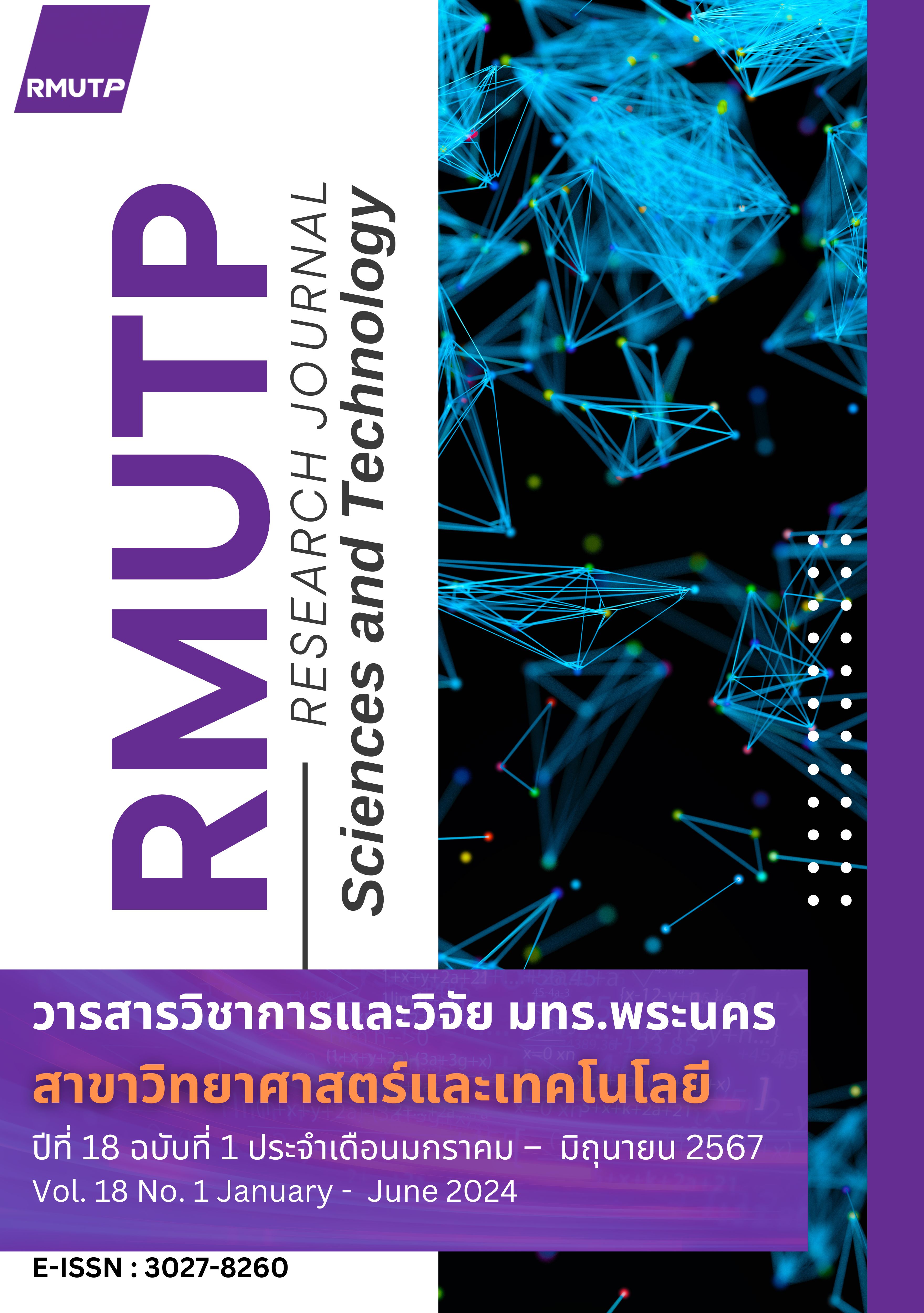Product Development of Ice Cream Fiber-Fortified from Pomelo Puree
Main Article Content
Abstract
Development of fiber-fortified ice cream product from pomelo puree with a stabilizer in 4 recipes of 5, 7, 10 and 15 % was demonstrated. The results showed that the overrun and viscosity value of ice cream increased whereas the melting rate significantly decreased depended on pomelo content. Ice cream without pomelo puree remained the highest in sensory acceptance, and with the addition of pomelo puree, overall acceptance decreased. The ice cream formula with 7% pomelo puree was the highest overall acceptance (6.28±1.88), with no statistically significant difference from the standard formula without pomelo puree added. Overrun was 41.15±0.59%, the viscosity was 698.02±5.56 cps, and melting rate at 30 minutes was 22.23±0.24%. In addition, chemical analysis of 7% pomelo puree ice cream found that total soluble solids was 25.28±1.88 °Brix, pH was 3.35±0.30, and moisture and fiber content were 71.72 and 7.73 percent respectively when compared to a controlled ice cream using a commercial substance (CREMODAN® SE 709-M; Danisco Thailand Co., Ltd.) as a stabilizer, it was found that pomelo puree -infused ice cream had significantly higher fiber content (p ≤ 0.05). Also, the storage of pomelo ice cream at -20 °c for 12 days showed a lower total number of microorganisms and coliform bacteria than a standard criterion of the Ministry of Public Health.
Article Details

This work is licensed under a Creative Commons Attribution-NonCommercial-NoDerivatives 4.0 International License.
ลิขสิทธ์ ของมหาวิทยาลัยเทคโนโลยีราชมงคลพระนครReferences
W. S. F. Chung, M. Meijerink, B. Zeuner, J. Holck, P. Louis, A. S. Meyer, J. M. Wells, H. J. Flint and S. H. Duncan, “Prebiotic potential of pectin and pectic oligosaccharides to promote anti-inflammatory commensal bacteria in the human colon” FEMS microbiology ecology, vol. 93(11), pp. 1-9, Nov. 2017.
J. Y. Huang, J. S. Liao, J. R. Qi, W. X. Jiang and X. Q. Yang, “Structural and physicochemical Properties of pectin-rich dietary fiber prepared from citrus peel” Food Hydrocolloids, vol. 110, pp. 106140. Jan. 2021.
W. Quan, Y. Tao, M. Lu, B. Yuan, J. Chen, M. Zeng, F. Qin, F. Guo and Z. He, “Stability of the phenolic compounds and antioxidant capacity of five fruit (apple, orange, grape, pomelo and kiwi) juices during in vitro‐simulated gastrointestinal digestion” International Journal of Food Science & Technology, vol. 53(5), pp.1131-1139. Nov. 2017.
R. Nazaruddin, A. Syaliza and A. Wan Rosnani, “The effect of vegetable fat on the physicochemical characteristics of dates ice cream” International journal of dairy technology, vol. 61(3), pp. 265-269. July. 2008.
M. Dervisoglu and F. Yazici, “The effect of citrus fibre on the physical, chemical and sensory properties of ice cream”. Food Science and Technology International, vol. 12(2), pp. 159-164. April. 2006.
A. P. Jardines, J. Arjona-Román, P. Severiano Pérez, A. Totosaus-Sánchez, S. Fiszman and H. Escalona-Buendía, “Agave fructans as fat and sugar replacers in ice cream: Sensory, thermal and texture properties” Food Hydrocolloids, vol. 108, pp. 106032. Nov. 2020.
A. Tiwari, H. K. Sharma, N. Kumar and M. Kaur, “The effect of inulin as a fat replacer on the quality of low‐fat ice cream” International journal of dairy technology, vol. 68(3), pp. 374-380. Nov. 2014.
W. Arbuckle, “Calculating cost and percentage of overrun Ice cream,” 1st ed. Springer, Boston, MA, 1986, pp. 184-200.
D. Parid, N. Rahman, A. Baharuddin, R. Kadir Basha, A. Mat Johari and S. Abd Razak, “Effects of carboxymethyl cellulose extracted from oil palm empty fruit bunch stalk fibres on the physical properties of low-fat ice cream” Food Research, vol. 5(1), pp. 1-7. Jan. 2021.
L. Prosky, N. G. Asp, T. F. Schweizer, J. W. Devries and I. Furda, “Determination of insoluble, soluble, and total dietary fiber in foods and food products: interlaboratory study” Journal of the Association of Official Analytical Chemists, vol. 71(5), pp. 1017-1023. Sep.1988.
Bacteriological Analytical Manual Online. (2001). Chapter 3: Aerobic Plate Count. USFDA. 10 pp. Retrieved March 11, 2022, from http://www.cfsan.fda.gov
X. Y. Wang, R. Xu, Y. X. Wang, L. Y. Ma, S. P. Nie, M. Y. Xie and J. Y. Yin, Physicochemical and rheological properties of pomelo albedo pectin and its interaction with konjac glucomannan” International journal of biological macromolecules, vol. 151, pp. 1205-1212. May. 2020.
M. Zhu, R. Huang, P. Wen, Y. Song, B. He, J. Tan, H. Hao and H. Wang, “Structural characterization and immunological activity of pectin polysaccharide from kiwano (Cucumis metuliferus) peels” Carbohydrate Polymers, vol.254, pp. 117371, Feb. 2021.
W. Wang, X. Ma, X, P. Jiang, L. Hu, Z. Zhi, J. Chen, T. Ding, X. Ye and D Liu, “Characterization of pectin from grapefruit peel: A comparison of ultrasound-assisted and conventional heating extractions,” Food Hydrocolloids, vol. 61, pp. 730-739, Dec. 2016.
M. W. Cheong, S. Q. Liu, W. Zhou, P. Curran and B. Yu, “Chemical composition and sensory profile of pomelo (Citrus grandis (L.) Osbeck) juice,” Food Chemistry, vol. 135(4), pp. 2505-2513, Dec. 2012.
S. Kumar, M. Khadka, R. Mishra, D. Kohli and S. Upadhaya, “Effects of conventional and microwave heating pasteurization on physiochemical properties of pomelo (Citrus maxima) juice,” Journal of Food Processing and Technology, vol. 8(7), pp. 1-4, July. 2017.
Food Act standard No.354 (Ice cream), Ministry of Public Health (2556). (online). Available URL; https://food.fda. moph.go. th/law/data/announ_moph/P354.pdf


